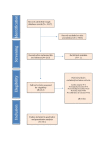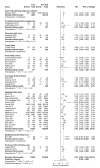Influence of Frailty on Outcome in Older Patients Undergoing Non-Cardiac Surgery - A Systematic Review and Meta-Analysis
- PMID: 33014537
- PMCID: PMC7505262
- DOI: 10.14336/AD.2019.1024
Influence of Frailty on Outcome in Older Patients Undergoing Non-Cardiac Surgery - A Systematic Review and Meta-Analysis
Abstract
Frailty is increasingly recognized as a better predictor of adverse postoperative events than chronological age. The objective of this review was to systematically evaluate the effect of frailty on postoperative morbidity and mortality. Studies were included if patients underwent non-cardiac surgery and if frailty was measured by a validated instrument using physical, cognitive and functional domains. A systematic search was performed using EMBASE, MEDLINE, Web of Science, CENTRAL and PubMed from 1990 - 2017. Methodological quality was assessed using an assessment tool for prognosis studies. Outcomes were 30-day mortality and complications, one-year mortality, postoperative delirium and discharge location. Meta-analyses using random effect models were performed and presented as pooled risk ratios with confidence intervals and prediction intervals. We included 56 studies involving 1.106.653 patients. Eleven frailty assessment tools were used. Frailty increases risk of 30-day mortality (31 studies, 673.387 patients, risk ratio 3.71 [95% CI 2.89-4.77] (PI 1.38-9.97; I2=95%) and 30-day complications (37 studies, 627.991 patients, RR 2.39 [95% CI 2.02-2.83). Risk of 1-year mortality was threefold higher (six studies, 341.769 patients, RR 3.40 [95% CI 2.42-4.77]). Four studies (N=438) reported on postoperative delirium. Meta-analysis showed a significant increased risk (RR 2.13 [95% CI 1.23-3.67). Finally, frail patients had a higher risk of institutionalization (10 studies, RR 2.30 [95% CI 1.81- 2.92]). Frailty is strongly associated with risk of postoperative complications, delirium, institutionalization and mortality. Preoperative assessment of frailty can be used as a tool for patients and doctors to decide who benefits from surgery and who doesn't.
Keywords: frailty; non-cardiac surgery; older patients; outcome; surgery.
copyright: © 2020 Tjeertes et al.
Figures






Similar articles
-
Impact of frailty on short-term postoperative outcomes in patients undergoing colorectal cancer surgery: A systematic review and meta-analysis.World J Gastrointest Surg. 2024 Mar 27;16(3):893-906. doi: 10.4240/wjgs.v16.i3.893. World J Gastrointest Surg. 2024. PMID: 38577090 Free PMC article.
-
Association Between the FRAIL Scale and Postoperative Complications in Older Surgical Patients: A Systematic Review and Meta-Analysis.Anesth Analg. 2023 Feb 1;136(2):251-261. doi: 10.1213/ANE.0000000000006272. Epub 2022 Nov 29. Anesth Analg. 2023. PMID: 36638509 Free PMC article.
-
Frailty and risk of complications in head and neck oncologic surgery. Systematic review and dose-response meta-analysis.Med Oral Patol Oral Cir Bucal. 2021 Sep 1;26(5):e582-e589. doi: 10.4317/medoral.24588. Med Oral Patol Oral Cir Bucal. 2021. PMID: 34414998 Free PMC article.
-
Effects of Frailty on Outcomes Following Surgery Among Patients With Hip Fractures: A Systematic Review and Meta-Analysis.Front Med (Lausanne). 2022 Mar 23;9:829762. doi: 10.3389/fmed.2022.829762. eCollection 2022. Front Med (Lausanne). 2022. PMID: 35402430 Free PMC article.
-
Association of frailty with adverse outcomes in surgically treated geriatric patients with hip fracture: A meta-analysis and trial sequential analysis.PLoS One. 2024 Jun 21;19(6):e0305706. doi: 10.1371/journal.pone.0305706. eCollection 2024. PLoS One. 2024. PMID: 38905251 Free PMC article.
Cited by
-
Beyond the revised cardiac risk index: Validation of the hospital frailty risk score in non-cardiac surgery.PLoS One. 2022 Jan 19;17(1):e0262322. doi: 10.1371/journal.pone.0262322. eCollection 2022. PLoS One. 2022. PMID: 35045122 Free PMC article.
-
Impact of preoperative frailty on outcomes in patients subjected to emergency laparotomy: a prospective study.Eur J Trauma Emerg Surg. 2025 Jan 24;51(1):34. doi: 10.1007/s00068-024-02752-z. Eur J Trauma Emerg Surg. 2025. PMID: 39853423
-
Preoperative Diagnostic Assessment of Patients with Cardiovascular Risk Factors Undergoing Noncardiac Surgery: A 2025 Update.Methodist Debakey Cardiovasc J. 2025 Aug 12;21(4):87-100. doi: 10.14797/mdcvj.1629. eCollection 2025. Methodist Debakey Cardiovasc J. 2025. PMID: 40822368 Free PMC article. Review.
-
The Impact of Frailty on Adverse Outcomes in Geriatric Hip Fracture Patients: A Systematic Review and Meta-Analysis.Front Public Health. 2022 Jun 30;10:890652. doi: 10.3389/fpubh.2022.890652. eCollection 2022. Front Public Health. 2022. PMID: 35844855 Free PMC article.
-
Impact of peri-operative frailty and operative stress on post-discharge mortality, readmission and days at home in Medicare beneficiaries.Anaesthesia. 2024 Aug;79(8):829-838. doi: 10.1111/anae.16301. Epub 2024 May 22. Anaesthesia. 2024. PMID: 38775305 Free PMC article.
References
-
- Mangano DT (2004). Perioperative medicine: NHLBI working group deliberations and recommendations. J Cardiothorac Vasc Anesth, 18:1-6. - PubMed
-
- Partridge JS, Harari D, Dhesi JK (2012). Frailty in the older surgical patient: a review. Age Ageing, 41:142-147. - PubMed
-
- Kristensen SD, Knuuti J, Saraste A, Anker S, Botker HE, De Hert S, et al. (2014). 2014 ESC/ESA Guidelines on non-cardiac surgery: cardiovascular assessment and management: The Joint Task Force on non-cardiac surgery: cardiovascular assessment and management of the European Society of Cardiology (ESC) and the European Society of Anaesthesiology (ESA). Eur J Anaesthesiol, 31:517-573. - PubMed
-
- Lee DH, Buth KJ, Martin BJ, Yip AM, Hirsch GM (2010). Frail patients are at increased risk for mortality and prolonged institutional care after cardiac surgery. Circulation, 121:973-978. - PubMed
-
- Polanczyk CA, Marcantonio E, Goldman L, Rohde LE, Orav J, Mangione CM, et al. (2001). Impact of age on perioperative complications and length of stay in patients undergoing noncardiac surgery. Ann Intern Med, 134:637-643. - PubMed
Publication types
LinkOut - more resources
Full Text Sources
Other Literature Sources
Research Materials
Miscellaneous
